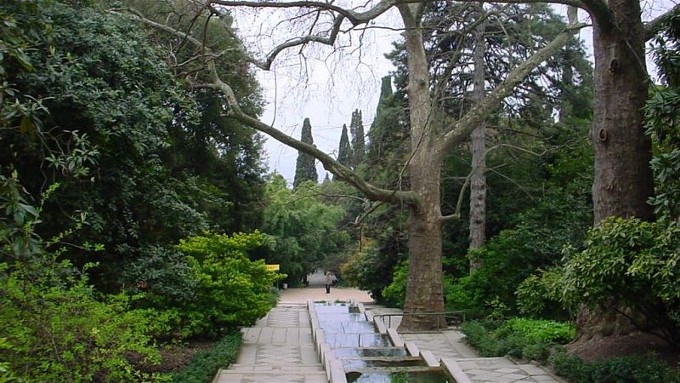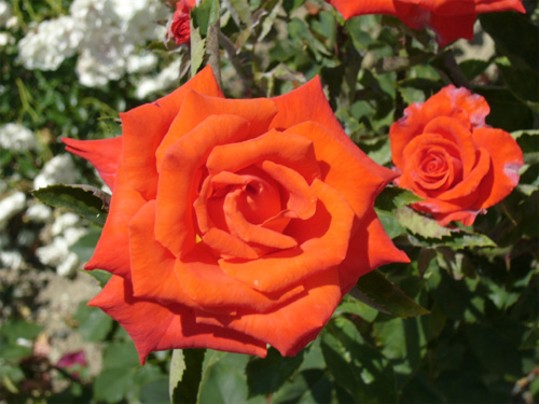Nikita Botanical Garden
Nikita Botanical Garden (Нікітський ботанічний сад; Nikitskyi botanichnyi sad). A scientific research complex located on the south side of the town of Nikita (renamed Botanichne 1971–91), 4.5 km east of Yalta, in the Crimea. Its founder and first director (1812–26) was Christian von Steven, a botanist of Swiss descent (born in Finland and educated in Sweden and Germany) and chief inspector of silkworm breeding in the southern Russian Empire. Under the sponsorship of Armand-Emmanuel du Plessis duc de Richelieu, the governor-general of New Russia, von Steven created the garden as an imperial repository of all useful and decorative Mediterranean and Asian plants, with the purpose of subsequently cultivating them throughout the region. The first Russian pomological collection (1817), a horticultural school (1823, closed down in 1921), vineyards and a wine-making school (1828), plantations of tobacco and medicinal plants, and a botanical cabinet and meteorological station (1908) were established there. The garden and its collections were expanded by the Livonian Nicolai Anders von Hartwiss, director from 1827 to 1860. In 1890 the garden began publishing its own collection, Zapiski (later renamed Trudy).
In 1920 the botanical garden had an area of approximately 136 ha. In 1924 it was designated an all-Union scientific institution. It began publishing a research bulletin in 1929, and research in plant selection and hybridization began there in the 1930s. Under the jurisdiction USSR Ministry of Agriculture and part of the All-Union Academy of Agricultural Sciences, it was expanded to cover an area of nearly 1,000 ha, employed 1,300 people, and consisted of 15 research departments and laboratories, a museum, archives, printing press, 4 parks, 4 experimental farms (near Yalta, Partenit, Gvardiisk, and Medvedivka), and the Cape Martian Nature Preserve (est 1973).
The garden’s scientists (approximately 120 in the 1980s) studied the Earth’s flora and introduced, acclimatized, and selected decorative, fruit- and nut-bearing plants, medicinal plants, essential-oil plants, and industrial crops for widespread use and production in Southern Ukraine, Moldova, Caucasia, and Central Asia. The garden had about 700,000 visitors annually. An illustrated Ukrainian-French book about it was published in 1987.
In post-Soviet Ukraine after 1991, it became part of the Ukrainian Academy of Agrarian Sciences with subsidiaries both in the Crimea and Kherson oblast. Its collection has grown to over 50,000 plant species, varieties, sorts, and hybrids cultivated there. Its library, the oldest and one of the best Ukrainian repositories of biological and agricultural literature, had holdings of over 207,700 books and periodicals; and its herbarium of Crimean flora had over 121,446 pages. In 1996 the cactus hothouse was established, representing one of the largest cactus and succulent plant collections in Europe. In 2003, however, some of its land—the rose garden and two of its parks, the Prymorskyi and Montedor—was transferred to the Scientific Research Institute of Naturopathy and Phytotherapy; the latter rented and then privatized the acquisition, with cottages built (2005) on 3.7 ha for important people (the premiers Serhii Kunitsyn of the Autonomous Republic of Crimea and Valerii Pustovoitenko of Ukraine, several deputies, and other political figures). Upon the celebration of the garden’s bicentennial in 2012, the management of Nikita Botanical Garden dismantled its monument to Vladimir Lenin (built in 1962).
Following Russian annexation of the Crimea in 2014 the Crimean Republic subordinated the garden to its Ministry of Education, Science and Youth, dismissed Valerii Yezhov (director of the garden since 1999) and appointed its new director (Yurii Pluhatar); in 2015 the garden was subordinated to the Russian Academy of Sciences and in 2018 to the Ministry of Science and Higher Education of the Russian Federation. In 2019 the Nikita Botanical Garden administration was required to rebuild the Lenin monument as it was and invalidate the land transfer to the Scientific Research Institute of Naturopathy and Phytotherapy.
Presently the Nikita Botanical Garden employs about 800 specialists. Research is divided among 5 thematic branches (1) dendrology, floriculture and landscape architecture, 2) natural ecosystems, 3) fruit cultures, 4) technical cultures and bioactive substances, 5) genome and post-genome research, and 4 other locations in the Crimea: 1) orchard experimental station at Salhyrka on the southern outskirts of Simferopol, 2) pomology station at the village of Verkhnesadove in Sevastopol, 3) the Prymorske branch of agro-technology and nursery of decorative plants, and 4) Dzhankoi introduction-quarantine nursery of agrotechnology and nursery science. The current area of the garden covers 1,576 ha on plots in 7 settlements of the Crimea with a variety of climate and soil conditions.
BIBLIOGRAPHY
Molchanov, E. Nikitskii botanicheskii sad: k 175-letiiu osnovaniia (Kyiv 1986)
Istoriia sozdaniia Nikitskogo botanicheskogo sada (Nikita 2024)
Ihor Stebelsky
[This article was updated in 2024.]
.jpg)
.jpg)

.jpg)

.jpg)
.jpg)